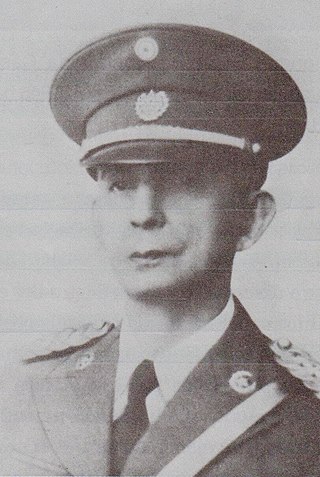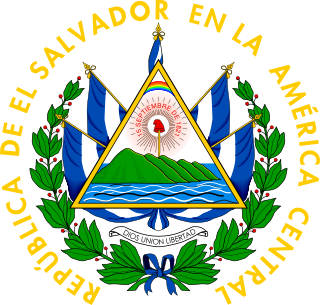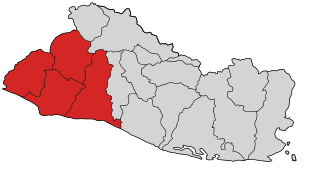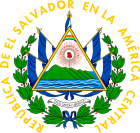
Maximiliano Hernández Martínez was a Salvadoran military officer and politician who served as the president of El Salvador from 4 December 1931 to 28 August 1934 in an acting capacity and again in an official capacity from 1 March 1935 until his resignation on 9 May 1944. He was the leader of El Salvador during World War II. While he served as President Arturo Araujo's vice president and defense minister, a directorate seized power during a palace coup and afterwards named Hernández Martínez president of El Salvador.

Osmín Aguirre y Salinas was a Salvadoran military officer and politician who served as the provisional president of El Salvador from 21 October 1944 until 1 March 1945. A Colonel in the Salvadoran Army, Aguirre y Salinas led two successful coups against the Salvadoran government: once in 1931 and once more in 1944. He left office in 1945, with the assurance that his successor in the next election would be Salvador Castaneda Castro. Aguirre y Salinas was later assassinated by left-wing guerrillas near his home in San Salvador at the age of 87.

Salvador Castaneda Castro was President of El Salvador from 1 March 1945 to 14 December 1948. He had previously served as Interior Minister under President Maximiliano Hernández Martínez. He was elected unopposed during martial law in January 1945, and was overthrown in a coup by other military officers in December 1948.

Legislative elections were held in El Salvador on 10 March 1991. The result was a victory for the Nationalist Republican Alliance, which won 39 of the 84 seats. Voter turnout was 44.7%.

La Matanza refers to a communist-indigenous rebellion that took place in El Salvador between 22 and 25 January 1932. After the revolt was suppressed, it was followed by large-scale government killings in western El Salvador, which resulted in the deaths of 10,000 to 40,000 people. Another 100 soldiers were killed during the suppression of the revolt.

Presidential elections were held in El Salvador on 5 March 1967. The result was a victory for Fidel Sánchez Hernández of the Party of National Conciliation, who won 54.4 percent of the vote.

Presidential elections were held in El Salvador on 20 February 1972. The result was a victory for Arturo Armando Molina of the Party of National Conciliation (PCN), who received 43% of the vote. However, the election was characterised by massive fraud. The PCN had faced a strong challenge from left- and right-wing opposition, and as a result had tried to rig the election by holding the presidential elections two weeks before the legislative election to ensure that if Molina failed to pass the 50% mark, the Legislative Assembly would still be under PCN control to approve him as president. Despite their attempts to stuff ballot boxes, it looked for a while as though José Napoleón Duarte of the opposition National Opposing Union had been victorious after the Central Election Board in San Salvador issued a statement that Duarte had won by around 6,000 votes. However, this was followed by a three-day news blackout, after which a revised set of figures was announced giving a narrow victory to Molina, meaning that the Legislative Assembly would choose the president. The opposition walked out of the vote, resulting in Molina being elected by 31 votes to zero.

General elections were held in El Salvador on 11 and 13 January 1931. Arturo Araujo won the presidential elections running on a Labor Party-National Republican Party ticket.

Presidential elections were held in El Salvador between 13 and 15 January 1935. Maximiliano Hernández Martínez was the only candidate and was returned unopposed.

Presidential elections were held in El Salvador on 3 January 1939. Maximiliano Hernández Martínez was the only candidate, and won unopposed.

Presidential elections were held in El Salvador in January 1944. Maximiliano Hernández Martínez was the only candidate and won the election, but no results were posted.

The Salvadoran military dictatorship was the period of time in Salvadoran history where the Salvadoran Armed Forces governed the country for almost 48 years from 2 December 1931 until 15 October 1979. The authoritarian military dictatorship limited political rights throughout the country and maintained its governance through rigged and fixed elections.

The National Party of the Fatherland, usually translated as the National Pro Patria Party or simply the Pro Patria Party, was a far-right political party which was the sole-legal political party in El Salvador from its establishment in 1933 until its dissolution in 1945. The party was founded by President General Maximiliano Hernández Martínez to support his government.

The 1931 Salvadoran coup d'état occurred on 2 December 1931. The coup overthrew President Arturo Araujo and led to the establishment of the Civic Directory. The coup began 48 years of military rule in El Salvador which lasted until the 1979 Salvadoran coup d'état.
The following lists events that happened in 1932 in El Salvador.
The following lists events that happened in 1944 in El Salvador.

Joaquín Valdés was a Salvadoran military officer who served as the Minister of National Defense from 1931 to 1935 and as Co-chairman of the Civic Directory in December 1931.

The Palm Sunday Coup was an attempted military coup d'état in El Salvador which occurred in early-April 1944. The coup was staged by pro-Axis sympathizers in the Salvadoran Army against President General Maximiliano Hernández Martínez.
Anarchism in El Salvador reached its peak during the labour movement of the 1920s, in which anarcho-syndicalists played a leading role. The movement was subsequently suppressed by the military dictatorship before experiencing a resurgence in the 21st century.











